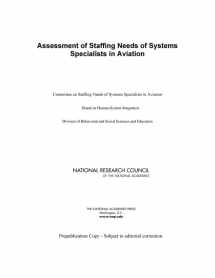
Assessment of Staffing Needs of Systems Specialists in Aviation
Book details
Summary
Description
Within the Federal Aviation Administration (FAA), the Airway Transportation System Specialists ATSS) maintain and certify the equipment in the National Airspace System (NAS).In fiscal year 2012, Technical Operations had a budget of $1.7B. Thus, Technical Operations includes approximately 19 percent of the total FAA employees and less than 12 percent of the $15.9 billion total FAA budget. Technical Operations comprises ATSS workers at five different types of Air Traffic Control (ATC) facilities: (1) Air Route Traffic Control Centers, also known as En Route Centers, track aircraft once they travel beyond the terminal airspace and reach cruising altitude; they include Service Operations Centers that coordinate work and monitor equipment. (2) Terminal Radar Approach Control (TRACON) facilities control air traffic as aircraft ascend from and descend to airports, generally covering a radius of about 40 miles around the primary airport; a TRACON facility also includes a Service Operations Center. (3) Core Airports, also called Operational Evolution Partnership airports, are the nation's busiest airports. (4) The General National Airspace System (GNAS) includes the facilities located outside the larger airport locations, including rural airports and equipment not based at any airport. (5) Operations Control Centers are the facilities that coordinate maintenance work and monitor equipment for a Service Area in the United States.
At each facility, the ATSS execute both tasks that are scheduled and predictable and tasks that are stochastic and unpredictable in. These tasks are common across the five ATSS disciplines: (1) Communications, maintaining the systems that allow air traffic controllers and pilots to be in contact throughout the flight; (2) Surveillance and Radar, maintaining the systems that allow air traffic controllers to see the specific locations of all the aircraft in the airspace they are monitoring; (3) Automation, maintaining the systems that allow air traffic controllers to track each aircraft's current and future position, speed, and altitude; (4) Navigation, maintaining the systems that allow pilots to take off, maintain their course, approach, and land their aircraft; and (5) Environmental, maintaining the power, lighting, and heating/air conditioning systems at the ATC facilities. Because the NAS needs to be available and reliable all the time, each of the different equipment systems includes redundancy so an outage can be fixed without disrupting the NAS.
Assessment of Staffing Needs of Systems Specialists in Aviation reviews the available information on: (A) the duties of employees in job series 2101 (Airways Transportation Systems Specialist) in the Technical Operations service unit; (B) the Professional Aviation Safety Specialists (PASS) union of the AFL-CIO; (C) the present-day staffing models employed by the FAA; (D) any materials already produced by the FAA including a recent gap analysis on staffing requirements; (E) current research on best staffing models for safety; and (F) non-US staffing standards for employees in similar roles.
Table of Contents- Front Matter
- Summary
- 1 Background and Overview
- 2 Work Environment Considerations for Airway Transportation Systems Specialists
- 3 Considerations in Creating a Staffing Model
- 4 FAA Approaches to Estimating Staffing of Airway Transportation Systems Specialists
- 5 Implementation and Sustainability of the Staffing Model
- References
- Appendixes
- Appendix A: Committee Biographies
- Appendix B: Open Session Speakers


We would LOVE it if you could help us and other readers by reviewing the book
Book review



